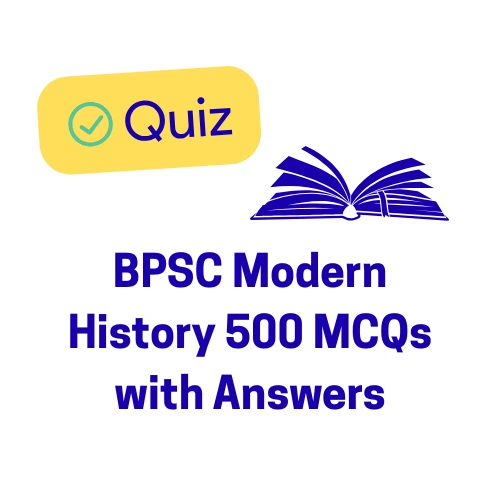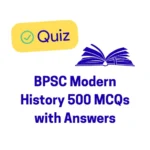BPSC Modern History Part 13 (500 MCQs) focus on the Cripps Mission, Quit India Movement, Subhas Chandra Bose and INA, and the major post-war developments (1940-1946).
BPSC Modern History Part 13 (500 MCQs)
Section GG: Pakistan Demand and August Offer
Q361. The demand for a separate Muslim state named ‘Pakistan’ was officially adopted for the first time by the Muslim League in which session?
(A) Lahore Session, 1940
(B) Lucknow Session, 1937
(C) Bombay Session, 1934
(D) Karachi Session, 1931
Q362. The term ‘Pakistan’ was coined much earlier (in 1933) by which individual?
(A) Muhammad Ali Jinnah
(B) Allama Iqbal
(C) Chaudhry Rehmat Ali
(D) Syed Ahmad Khan
Q363. The August Offer (1940) was proposed by which Viceroy of India?
(A) Lord Wavell
(B) Lord Linlithgow
(C) Lord Mountbatten
(D) Lord Curzon
Q364. Which of the following was/were the promise(s) included in the August Offer?
Immediate grant of Dominion Status to India.
Establishment of a Constituent Assembly after the war.
Increasing the number of Indians in the Viceroy’s Executive Council.
(A) 1 and 2 only
(B) 2 and 3 only
(C) 1 and 3 only
(D) 1, 2, and 3
Q365. In rejection of the August Offer, the Congress launched the Individual Satyagraha in 1940. Who was chosen by Mahatma Gandhi as the first Satyagrahi?
(A) Jawaharlal Nehru
(B) Vinoba Bhave
(C) Sardar Vallabhbhai Patel
(D) Subhas Chandra Bose
BPSC Modern History Part 13 (500 MCQs)
Q366. The Individual Satyagraha was also known as the ‘Delhi Chalo Movement’ because:
(A) Satyagrahis aimed to march to the capital, Delhi, from their respective places.
(B) It was formally launched from Delhi.
(C) It was designed to coincide with a meeting in Delhi.
(D) The British government called it the ‘Delhi Chalo Movement’ as a derogatory term.
Q367. The second person chosen by Gandhi to be an Individual Satyagrahi was:
(A) Rajendra Prasad
(B) Subhas Chandra Bose
(C) Jawaharlal Nehru
(D) C. Rajagopalachari
Q368. Who served as the President of the Indian National Congress for the longest continuous term, starting from 1940?
(A) Jawaharlal Nehru
(B) Subhas Chandra Bose
(C) Maulana Abul Kalam Azad
(D) Acharya Kripalani
Q369. Subhas Chandra Bose famously escaped from his house arrest in Calcutta in 1941 and traveled to which country initially to seek assistance against the British?
(A) Japan
(B) Germany
(C) Italy
(D) Soviet Union
Q370. The Indian National Congress rejected the August Offer primarily because it did not include the immediate grant of:
(A) Purna Swaraj
(B) Dominion Status
(C) Responsible Government at the Centre
(D) Right to Self-determination
Section HH: Cripps Mission and Quit India Movement
Q371. The Cripps Mission visited India in which year?
(A) 1940
(B) 1942
(C) 1944
(D) 1945
Q372. The Cripps Mission proposed which of the following?
(A) Complete and immediate independence.
(B) The creation of two separate nations, India and Pakistan.
(C) Dominion Status to India after World War II.
(D) A Constituent Assembly formed entirely by the Indian people during the war.
Q373. Mahatma Gandhi famously described the Cripps proposal as a “post-dated cheque on a crashing bank”. The “crashing bank” referred to:
(A) The collapse of the Muslim League.
(B) The British control over India.
(C) The collapse of the Allied power’s war efforts.
(D) The economic condition of the world.
Q374. The Quit India Resolution was ratified at which session of the INC?
(A) Wardha Session, 1942
(B) Bombay Session, August 1942
(C) Lahore Session, 1929
(D) Meerut Session, 1946
Q375. The slogan ‘Do or Die’ (Karo Ya Maro) was given by which leader at the time of the Quit India Movement?
(A) Jawaharlal Nehru
(B) Subhas Chandra Bose
(C) Mahatma Gandhi
(D) Sardar Vallabhbhai Patel
BPSC Modern History Part 13 (500 MCQs)
Q376. In the immediate aftermath of the Quit India Resolution, all top INC leaders were arrested under which operation?
(A) Operation Red
(B) Operation Thunder
(C) Operation Zero Hour
(D) Operation Blue Star
Q377. The Quit India Movement saw the emergence of several parallel governments (Prati Sarkar). Which city/region saw the longest-lasting parallel government (up to 1944)?
(A) Ballia (UP)
(B) Satara (Maharashtra)
(C) Tamluk (Midnapore, Bengal)
(D) Talcher (Orissa)
Q378. Who among the following leaders played a crucial role in leading the underground resistance movement during the Quit India Movement?
(A) Aruna Asaf Ali
(B) Jayaprakash Narayan (J. P. Narayan)
(C) Ram Manohar Lohia
(D) More than one of the above
Q379. Which prominent female freedom fighter is remembered for hoisting the Indian flag at the Gowalia Tank Maidan during the start of the Quit India Movement?
(A) Sarojini Naidu
(B) Sucheta Kripalani
(C) Aruna Asaf Ali
(D) Usha Mehta
Q380. Who started the underground radio station, ‘Congress Radio’, during the Quit India Movement?
(A) Usha Mehta
(B) R. M. Lohia
(C) Aruna Asaf Ali
(D) J. P. Narayan
Section II: INA, Wavell Plan, and Cabinet Mission
Q381. The idea of the Indian National Army (INA) or Azad Hind Fauj was originally conceived by:
(A) Subhas Chandra Bose
(B) Captain Mohan Singh
(C) Rash Behari Bose
(D) V. D. Savarkar
(E) None of the above / More than one of the above
Answer: (B) Captain Mohan Singh (1942)
Q382. Subhas Chandra Bose took over the leadership of the INA from Rash Behari Bose in which country?
(A) Germany
(B) Singapore
(C) Japan
(D) Malaya
Q383. The INA comprised prisoners of war (POWs) captured by the Japanese from which country’s army?
(A) French
(B) Dutch
(C) British
(D) American
Q384. Subhas Chandra Bose established the Provisional Government of Free India (Arzi Hukumat-e-Azad Hind) in which city in 1943?
(A) Rangoon (Burma)
(B) Tokyo (Japan)
(C) Singapore
(D) Berlin (Germany)
Q385. The famous INA trials (Red Fort Trials) were held in 1945. Which of the following officers was/were put on trial?
Shah Nawaz Khan
Prem Kumar Sahgal
Gurbaksh Singh Dhillon
(A) 1 and 2 only
(B) 2 and 3 only
(C) 1 and 3 only
(D) 1, 2, and 3
BPSC Modern History Part 13 (500 MCQs)
Q386. The Wavell Plan was announced in 1945 and proposed the formation of a new:
(A) Constituent Assembly
(B) Interim Government at the Centre
(C) Federal Court
(D) All-India Federation
Q387. The conference held in 1945 to discuss the Wavell Plan and the composition of the executive council was the:
(A) Karachi Conference
(B) Shimla Conference
(C) Poona Conference
(D) Lahore Conference
Q388. The Cabinet Mission (1946) did not accept the Muslim League’s demand for a separate state of Pakistan. Instead, it proposed:
(A) Immediate transfer of power to the INC.
(B) An All-India Union with three groups of provinces (A, B, and C).
(C) The holding of a referendum in all Muslim-majority provinces.
(D) Division of the army and the civil services before independence.
Q389. The Cabinet Mission Plan was initially accepted by:
(A) The Indian National Congress
(B) The Muslim League
(C) Both the INC and the Muslim League
(D) Neither the INC nor the Muslim League
Q390. Which day was observed by the Muslim League as the ‘Direct Action Day’ in 1946, leading to massive communal riots, particularly in Calcutta?
(A) August 16, 1946
(B) September 2, 1946
(C) October 26, 1946
(D) December 9, 1946

